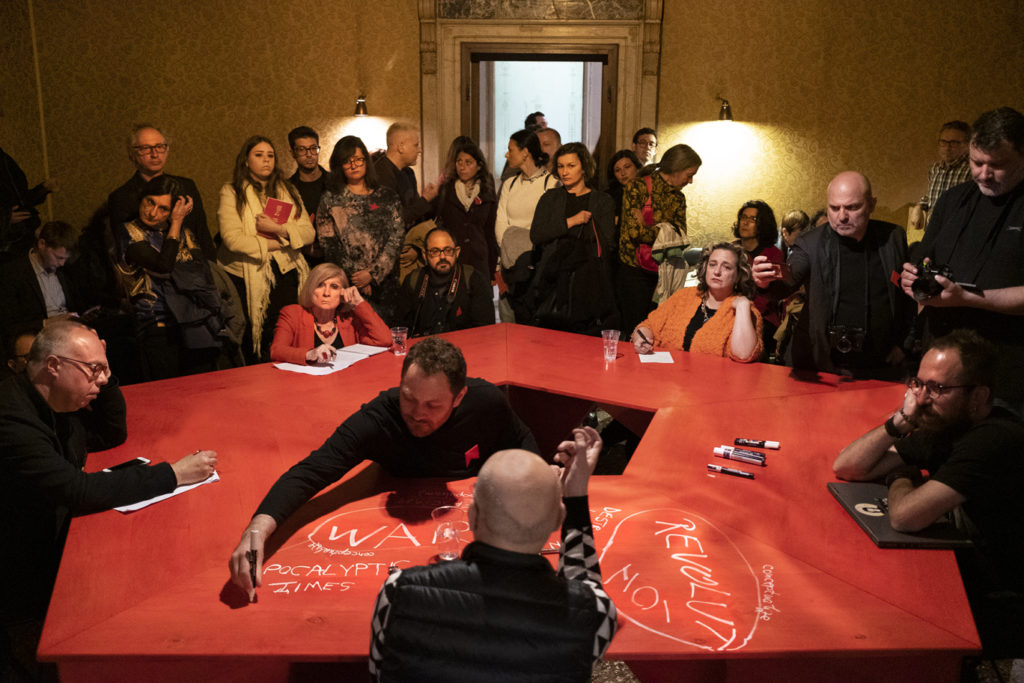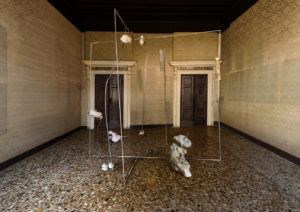Parole, Parole (As a Counter-Hegemonic Gesture): Red Discussion No. 2 (Pavilion of the Republic of North Macedonia; Maja Ćirić)
Parole, parole(The reference is to the famous Italian duet performed in 1972 by Mina and Alberto Lupo about appealing yet hollow, empty words.) (As a Counter-hegemonic Gesture): Red Discussion No. 2, part of Subversion to Red by Nada Prlja for The Pavilion of The Republic of North Macedonia
The number of professionals in the fields of the arts and humanities who are capable of critically reflecting upon the planetary condition appears to be small. Fewer still are those who express any critical, communal, or selfless interest in connecting the legacy of the arts and humanities to the political anxieties of contemporary times. Ideally, of course, the Venice Biennale provides the possibility of commenting—in solidarity with cultural workers around the world—on such “interesting times.” (“May You Live In Interesting Times” is the title of this year’s Biennale.) Nonetheless, it takes a special effort by artists and curators to turn away from individualistic concerns and instead attempt to put forward a neo-communist framework of equality, to take a radically inclusive—yet paradoxically utopian—stance that could truly serve all the parties involved in the Biennale, individual and geopolitical alike. Take, for example, the representation of the geographical and mental region called the Balkans—a name that now stands in marked contrast to the market-oriented term “South-East Europe,” a region whose real imperatives became competitiveness and inequality. Among the artists representing this region at the 58th Venice Biennale is Nada Prlja, in the Pavilion of the Republic of North Macedonia. Arguably, regionalism is a thing of the past: everything that is said or done echoes everywhere around the world. For better or worse, however, the past still haunts us.

Nada Prlja, Red Discussion 2, 2019. Live art event (with Charles Esche, Maurizio Lazzarato, Vlad Morariu, Chantal Mouffe, Laura Raicovich and Artan Sadiku). 6 participants, table, markers, 340x340x120cm, two-hour performance. Image courtesy of Nada Prlja. Photo © Ana Lazarevska.
In response to this haunting, in the pavilion Prlja looks for a way to channel the timeless multitudes of the past and the present—to merge the provincial with the metropolitan character of contemporary social and artistic practices. Prlja is a London-based artist whose practice frequently examines questions of inequality, injustice, otherness, and migration, as well as critical discourses around nationalism, and transition in former socialist countries. In her contribution to this year’s Biennale, the artist attempts to articulate both the material and immaterial traces of former times, seeking to intertwine the sharp ideological contradictions persisting in the present with the immanent blurriness of our shared prospects. Needless to say, this effort would be a daring task even were it not for the aforementioned crisis of global and regional geopolitical values that haunts our “interesting times.”
Housed at the Palazzo Rota Ivancich—an architectural symbol of decadence—Prlja’s contribution to the Biennale is entitled Subversion to Red, and represents the continuation of an ongoing art project that includes substantial documentation consisting of prior video works, live events, and installations created over the past several years. It also includes a new installation of sculptures and paintings entitled Subtle Subversion, The Collection: She Does What She Wants (discussed below).
One of the most pivotal elements of Subversion to Red, however, is Red Discussion 2, an event that took place at the opening ceremony of the pavilion. Red Discussion 2 is the sequel to Red Discussion 1, an earlier “live art event” (as the artist calls it). Red Discussion 1 was conceived as a discussion amongst a group of important thinkers and theorists who were invited to analyze and critique a range of concepts.(Speakers at Red Discussion 1 included Dave Beech, Hannah Black, Gail Day, Mark Fisher, and Nina Power. The event was chaired by Vlad Morariu. See https://nadaprlja.com/red-discussion-live-art-2013/?fbclid=IwAR3_fPoZxL8hsDTCamkqkZkn85vkQXGcmklCvVphXGUioptF94LNMRRId0c (accessed October 10, 2019).) At both discussions, the participants gathered around a red pentagonal table, writing a plethora of words and phrases on it as their debates ranged. The project was documented by a video, and the table itself is preserved as an artifact of Red Discussion 2 in the pavilion.

Nada Prlja, Red Discussion 2, 2019. Live art event (with Charles Esche, Maurizio Lazzarato, Vlad Morariu, Chantal Mouffe, Laura Raicovich and Artan Sadiku). 6 participants, table, markers, 340x340x120cm, two-hour performance. Image courtesy of Nada Prlja. Photo © Ana Lazarevska.
The Venetian version of the Red Discussion occurred under uneven concentric circles cast by dimmed lights on the rainy Venice Biennale preview night of May 8. At the center of the event (and the pentagonal table positioned in the middle of the room) was researcher Vlad Morariu, acting as a moderator; “a character from Dante’s purgatory” would be a perfect description of his actions, if the pavilion’s title Subversion to Red did not already evoke a Marxist optics. His task was to cater to everyone’s needs, a constantly revolving position that was a priori demanding, since whatever he did caused him to turn his back to at least two of the five interlocutors sitting around the table, in the center of which he stood. These five interlocutors were: Chantal Mouffe, political theorist; Laura Raicovich, writer and art worker; Maurizio Lazzarato, sociologist and philosopher; Charles Esche, curator; and Artan Sadiku, philosopher. During the event, various ideas and keywords were written onto the table, which served as a platform to build up and define a set of key concepts and ideas that could be used as a guide for redefining contemporary society. At the beginning of Red Discussion 2, each of the five central discussants introduced their worldview by proposing two concepts, or parole, parole. Mouffe opted for hegemony and agonism,(These two concepts (the former developed from Gramsci) form the groundwork of a theory of radical democracy based on social antagonisms, put forward in several of Mouffe’s writings, including her book with Ernesto Laclau, Hegemony and Socialist Strategy: Towards a Radical Democratic Politics (New York: Verso, 2001).) Lazzarato for rivoluzione (in Italian) and war. Esche proposed the concepts de-modernization (by which he meant turning away from a constraining modernist canon in order to allow for different epistemologies of culture to emerge) and being-in-common. Raicovich chose care and collectivity, while Sadiku contributed his thoughts on time and labor.
While a heated debate unfolded within this inner circle seated around the table, a second circle beyond it consisted of semi-silent witnesses standing, sitting, and walking by. Most of them were art workers, at least one prominent mid-aged curator from each Balkan country as well as artists of all generations, some from the Balkans and others from the broader global artworld. Their presence and participation at the event indicated a sense of purpose and solidarity that caused them to skip the glamorous Venice Biennale preview dinner and instead gather to witness Red Discussion 2. In their act of choosing, they took up Prlja’s invitation to participate in a subversion, from the concept of the art industry and opted for an intellectual, interdisciplinary production of common-sense. They spontaneously formed a public realm between the critical thinkers in the inner circle and the artworks exhibited elsewhere in the pavilion. If subversion is to be found, it is in acts of denouncing the common superficial political representations at the Venice Biennale.
The artworks exhibited in the other rooms of the palazzo are being shown under the title Subtle Subversion, The Collection: She Does What She Wants, which is Prlja’s direct intervention in and comment upon the collection of the Museum of Contemporary Art (MoCA) in Skopje. The abstract sculptures of Serbian artist Olga Jevrić, who represented Yugoslavia at the Venice Biennale in 1958, or the legacy of the Macedonian artist Boris Nikoloski, for example, are still recognizable, but they have been reshaped by Prlja.(For more information on the works that are installed in the pavilion, see the pavilion’s website, https://2019northmacedonia-labiennale.art/series-subtle-subversion/?fbclid=IwAR3edf9_Z8WWd0dng2qmoLCIzqvTP8ixHoJ2SCmj0Hf5K-QVg8PlfDZ_jmM (accessed October 10, 2019).) During Red Discussion 2, the presence of these artworks played little direct role, but they did point to two different, though not mutually exclusive, affiliations that Prlja cultivates in her practice. One is representational and artistic (consisting of physical objects in an exhibition space), the other aspires to be interventionist, theoretical, and activist (as exemplified by the event of Red Discussion 2).

Nada Prlja, The Collection: She Does What She Wants, Untitled I, 2019. 280 x 280 x 280cm. Metal profiles, concrete, stones, cast fragments, metal dust, wood, glass, readymade objects. Image courtesy of Nada Prlja. Photo © Ana Maljanovska.
While the heart of Red Discussion 2 was the theoretical debate unfolding around the table, all the other impulses at play were equally important, the kinds of factors that only Walter Benjamin’s optical unconscious can register: agonisms around the very table manifested in the shadows, and dimmed lights. There was hushed restraint from speaking up in the second circle, as the debate at the inner circle was already passionate enough. The inner circle discussed primarily amongst themselves, while the second circle non-verbally reacted to these discussions.
While all the other terms or concepts (in)directly resonated within the regional context, the colonial issue raised by Charles Esche seemed detached from any specificities, such as the relation to the Ottoman and Austro-Hungarian Empires, or to the conditions of peripheral predatory capitalism. To mention colonialism in the context of post-socialist “redness,” which also had an astonishing and original approach to modernism, was a daunting task, considering the (post-)Yugoslav role within the Non-Aligned Movement, which cultivated an idealist view towards non-Western others.(Needless to say, present in the passers by were also art world representatives and art workers from the African continent.) The legacy of socialist brotherhood has for a long time been opposed to imperialist exploitation. Esche’s aim was to heal (the general yet really not general) “wound of colonialism” and “to de-colonize the matrix of power,” but Chantal Mouffe rightly pointed out that “the Occident is quintessentially racist” and that “searching for the modern in other cultures is theoretically unstable.” She also asserted that “human rights recognition is in favor of the dignity of the oppressor,” not the oppressed. Ultimately, the free-floating character of the question of colonialism at the table pointed to the importance of context-responsiveness and context-specificity—in both time and geography—when addressing the histories and current legacies of colonialism.
Prlja’s Red Discussion 2 assembled both a particular scenography and a crowd on the idealist assumption that culture really can influence political change. On the other hand, what she has attempted to achieve is the mobilization of an agonistic public realm embedded in social-political theory at the pavilion. By doing so, Prlja also constructed shared public interest in the subversion of earlier, more conservative, and less critical representations of her country, which resulted in a trans-national discursive and activist vision of its possibilities. However, when appropriation and the recycling of ideologies and form become transgressive, they—like any other transgression—also become more manipulative (something Mouffe also pointed out in her expose at the event). No matter how the traces of older artworks are recuperated, they remain deprived of the irrational energy they once possessed, and thus fit into a simply counter-hegemonical framework. Likewise, old ideological frameworks tend to lose their radicality and be assimilated into new logics of capitalism so much evident at the Venice Biennale. Prlja’s Red Discussion 2 made visible a number of existing and critical discourses that importantly—and for a considerate period of historical time—have shaped both the artworld and global politics. However, in order to escape from the confines of rationality and to find an irrational alternative to these discourses, one would have to avoid any recycling or re-appropriation. A truly non-hegemonic experiment intogetherness would be one that abandons all known analysis, one that is no longer limited and constrained by the past.
Subversion to Red as a whole is a critical culturally discursive project, rather than a merely artistic one. It puts contemporary hegemonic discourses and paradigms into question, but at the same time it cannot escape from them.
Articles in this special issue:
[su_menu name=”Venice Biennale”]




